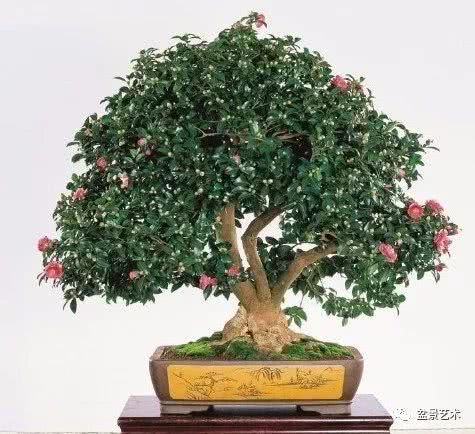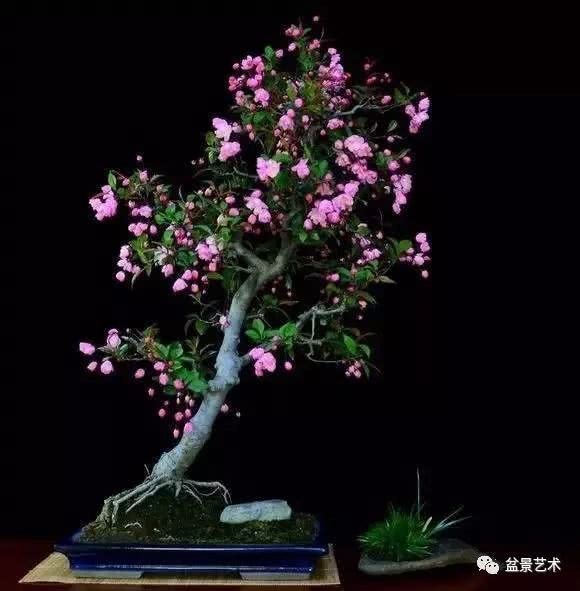We should learn how to shape the bonsai of camellia.

Among the many plants of Sichuan style bonsai, camellia is one of the earliest tree species.
Camellia is one of the top ten famous flowers in China. With the characteristics of not withering through winter, fighting frost and showing off color, camellias dress up in winter and early spring gardens. If used in bonsai, it can make the interior glowing and vibrant with its elegant and dignified plant shape, bright green leaves and beautiful but not demon flowers.
First, the bonsai sexual habit of camellias
Tea, which originated in the mountains of the Yangtze River Basin in China, is a component tree species of ancient subtropical forests. Because it has escaped from the forest for planting for only more than a thousand years, it still has significant subtropical forest plant habits and prefers slightly acidic loess. Therefore, do not use poorly drained dead yellow mud and old sandwiched soil when going on the basin. Otherwise, it will cause the plant not to be sprouting and not long, so that the root system will blacken and rett and die. Also avoid direct sunlight, like the air humidity of the semi-shade environment.
Second, upper basin and flat tie
For camellias used in bonsai, seedlings should be selected in the garden with a large distance between plants. The selected plants should be camellias with shorter branches, more branches, uniform leaves, normal development and no diseases and insect pests.
The flower bud differentiation period of camellia begins to form buds in May and June. The best pot season is in February and August of the lunar calendar in the Spring and Autumn period. At this time, the leaf buds of camellias have just germinated or not much, and the young shoots and young leaves after transplanting will not wilt and affect their growth. If you want to serve the basin in other seasons, you should keep more soil balls and move them to a cool place for a few days. Even so, it does not grow as vigorously as in February or August. For upper basin soil, mountain humus soil or hilly red sandy soil (Pinus massoniana, Camellia oleifera forest soil) should be used.
The upper basin shape of camellias is generally overhanging rock type and rolling branches. The hanging rock type basin can use Yixing Gaozu dry tube basin or Gaozhuang barrel basin, and the rolling branch type basin can use proportional round basin and square basin.
The camellias used for bonsai should be planted obliquely when they are placed in the pot, which is beneficial to the operation of the trunk method. Generally speaking, the body method of bending the trunk first is beneficial to the flat branches. Common body methods can be used to drop crutches and rolling dragon pole crutches. When the trunk is flat, the lateral branches, twigs and leaves of camellias should be retained. After the trunk is formed, the side branches are processed. The way of the flat branch of the lateral branch can be determined according to the format characteristics that the branch should occupy, using vertical bending, oblique bending and irregular bending respectively to fill the gap on the surface of the crown. The above flat straps are all tied with brown silk. The flat binding operation should be carried out after the new branch hardens, that is, about one month after the basin. As the wood hardness of camellias is strong, like sweet-scented osmanthus and golden marbles, we should carefully "knead the branches" in the operation of each turn, that is, each small section of the branches involved in this bend should be kneaded first, and the bark phloem of the branches will be stretched and compressed after bending in the positive and negative directions, so that the xylem can adapt to the action of external force through extrusion and stretching, so that the brown silk can be tied up. Otherwise, the branches of the plant will be broken due to the increase of sap after modeling.
Finally, the leaf surface of each leaf is made outward through the flat binding of the twigs. Because the trees with rolling branches are flowers and trees with flowers in their axils (camellia, sweet-scented osmanthus, plum blossoms, wax plum, elm-leaf plum, etc.), the effect after modeling is that they can blossom everywhere in a spherical or Obovate plant crown to show elegance. Therefore, the process of tying twigs and turning leaves should be carried out in more detail. In order to make the camellia leaves on the branches turn outward, the twigs should be finely twisted and twisted, not only not broken, but also to achieve the effect of turning leaves. After the completion of the operation, individual redundant branches and leaves that cannot be dealt with can be cut off. If some gaps in flat ligation need to be supplemented by young shoots, they can only be carried out after the young shoots are aged and hardened.
- Prev

A fish worth thousands of dollars is thrown four times?
Exclaim! Recently, a piece of news blew up. An arowana was loaded into a plastic bag by a fish friend for 4 times. The editor saw that he could not restrain the power of his heart. Although the arowana is not seriously ill afterwards, it is difficult to guarantee whether there are sequelae or not. Send it like this.
- Next

Bonsai production of crabapple with vertical silk
(1) Botanical knowledge belongs to Rosaceae and Malus. Small deciduous trees with whirling posture and purple branches. Leaves ovate or elliptic, margin obtusely serrulate. Flowering between March and April, every 4-7 clusters, pedicels purple, slender and drooping,.
Related
- Wuhan Hospital Iron Tree Blooming Result Was Instantly Frightened by the Gardener Master
- Which variety of camellia is the most fragrant and best? Which one do you like best?
- What is the small blue coat, the breeding methods and matters needing attention of the succulent plant
- Dormancy time and maintenance management of succulent plants during dormancy
- Minas succulent how to raise, Minas succulent plant pictures
- What are the varieties of winter succulent plants
- How to raise succulent plants in twelve rolls? let's take a look at some experience of breeding twelve rolls.
- Attention should be paid to water control for succulent plants during dormant period (winter and summer)
- Watering experience of twelve rolls of succulent plants
- Techniques for fertilizing succulent plants. An article will let you know how to fertilize succulent plants.

